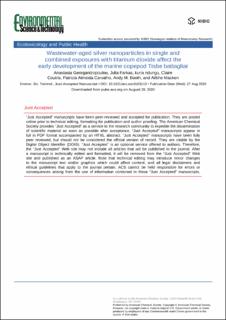| dc.contributor.author | Georgantzopoulou, Anastasia | |
| dc.contributor.author | Farkas, Julia | |
| dc.contributor.author | Ndungu, Kuria | |
| dc.contributor.author | Coutris, Claire | |
| dc.contributor.author | Almeida Carvalho, Patricia | |
| dc.contributor.author | Booth, Andy | |
| dc.contributor.author | Macken, Ailbhe | |
| dc.date.accessioned | 2020-10-28T09:54:42Z | |
| dc.date.available | 2020-10-28T09:54:42Z | |
| dc.date.created | 2020-09-04T10:15:06Z | |
| dc.date.issued | 2020 | |
| dc.identifier.issn | 0013-936X | |
| dc.identifier.uri | https://hdl.handle.net/11250/2685448 | |
| dc.description | This document is the unedited Author’s version of a Submitted Work that was subsequently accepted for publication in Environmental Science and Technology, copyright © American Chemical Society after peer review. To access the final edited and published work see https://pubs.acs.org/doi/10.1021/acs.est.0c03113 | en_US |
| dc.description.abstract | In this study, the effects of aged Ag and TiO2 NPs, individually and as a mixture, in wastewater relative to their pristine counterparts on the development of the copepod nauplii (Tisbe battagliai) were investigated. NP behavior in synthetic wastewater and seawater was characterized during aging and exposure. A delayed development and subsequent mortality was observed after 6 days of exposure to aged Ag NPs, with a 2-fold decrease in EC50 (316 μg/L) compared to pristine NPs (EC50 640 μg/L) despite the similar dissolved Ag concentrations measured for aged and pristine Ag NPs (441 μg/L and 378 μg/L, respectively). In co-exposures with TiO2 NPs, higher dissolved Ag levels were measured for aged NPs (238.3 μg/L) relative to pristine NPs (98.57 μg/L). Co-exposure resulted in a slight decrease (15%) in the Ag NP EC50 (270 μg/L) with a 1.9-fold increase in Ag NP retained within the organisms after depuration (2.82% retention) compared to Ag NP single exposures as measured with sp-ICP-MS suggesting that the particles are still bioavailable despite the heteroaggregation observed between Ag, Ti NPs and wastewater components. This study shows that the presence of TiO2 NPs can affect the stability and toxicity of Ag NPs in complex media that cannot be predicted solely based on ionic, total or nanoparticulate concentrations and the need for studying NP interactions in more complex matrices is highlighted. | en_US |
| dc.language.iso | eng | en_US |
| dc.publisher | ACS Publications | en_US |
| dc.rights | Attribution-NonCommercial-NoDerivatives 4.0 Internasjonal | * |
| dc.rights.uri | http://creativecommons.org/licenses/by-nc-nd/4.0/deed.no | * |
| dc.title | Wastewater-aged silver nanoparticles in single and combined exposures with titanium dioxide affect the early development of the marine copepod Tisbe battagliai | en_US |
| dc.type | Peer reviewed | en_US |
| dc.type | Journal article | en_US |
| dc.description.version | acceptedVersion | en_US |
| dc.rights.holder | Copyright © 2020 American Chemical Society | en_US |
| dc.source.pagenumber | 12316-12325 | en_US |
| dc.source.volume | 54 | en_US |
| dc.source.journal | Environmental Science and Technology | en_US |
| dc.source.issue | 19 | en_US |
| dc.identifier.doi | 10.1021/acs.est.0c03113 | |
| dc.identifier.cristin | 1827303 | |
| dc.relation.project | Norges forskningsråd: 238972 | en_US |
| cristin.ispublished | true | |
| cristin.fulltext | postprint | |
| cristin.qualitycode | 2 | |

